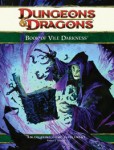 This roleplaying game product is intended for Dungeon Masters looking to broaden their campaigns to include dark subject matter and truly evil threats. It features a detailed look at the nature of evil and the complex challenge of confronting the many dilemmas found within the deepest shadows. Filled with malignant secrets and musings that can inspire adventures or entire campaigns, The Book of Vile Darkness provides Dungeon Masters with sample roleplaying encounters, adventure hooks, skill challenges, rituals, and lore for some of the most despicable creatures to infest any campaign world, plus new character options for players who like to flirt with evil, and a full-color, double-sided poster map presenting iconic evil sites for heroes to explore.
This roleplaying game product is intended for Dungeon Masters looking to broaden their campaigns to include dark subject matter and truly evil threats. It features a detailed look at the nature of evil and the complex challenge of confronting the many dilemmas found within the deepest shadows. Filled with malignant secrets and musings that can inspire adventures or entire campaigns, The Book of Vile Darkness provides Dungeon Masters with sample roleplaying encounters, adventure hooks, skill challenges, rituals, and lore for some of the most despicable creatures to infest any campaign world, plus new character options for players who like to flirt with evil, and a full-color, double-sided poster map presenting iconic evil sites for heroes to explore.
Ethics in RPG’s: Part 2: The Ethical Theories in D&D
Introduction: The System
In this second part on Ethics in RPG’s I am attempting to apply the major Ethical Theories to the alignment system of Dungeons & Dragons. I’m using D&D 3.5 as my “base,” but this easily applies to 4th Edition, Paizo’s Pathfinder and any other similar “two axis” alignment system.
What is a “Two-Axis Alignment System”? That’s my label for how D&D 3.5 models their alignment chart. There are two axes: 1) Good-Evil, 2) Law-Chaos to create their well-known alignment chart.
The Purpose however, is to help the reader in creating a fuller, deeper character. To better understand your character’s motivations creates a better role-playing experience for all.
Direct Correlations
I begin with the most natural intersections between the Ethical Theories and particular alignments.



